The interstates and major highways are closed down due to weather conditions, but you still need to get your load to its destination. Is there anything you can do?
Whatever the reason, it’s clear that when storms occur, they are getting stronger and more dangerous. From blinding snow to flooding caused by rainstorms and hurricanes, our roads are becoming more treacherous, turning into obstacle courses or, even worse, parking lots as traffic slows down or just stops.
In her recent IdeaXchange blog, Jane Clark, Vice President of Member Services for NationaLease discusses what fleets and owner-operators should do in case of truly bad weather. What she makes clear is that all the responsibility should not fall on the driver. Dealing with horrific weather conditions needs to be a joint effort involving drivers, dispatchers, and state and local authorities.
When drivers are faced with the decision of whether to simply wait in traffic or try to find an alternative route, they may often choose the latter. As Jane notes, in the recent storms in the Northeast and Midwest, “when state highways were shut down, truckers moved on to secondary roads with disastrous results.” These local roads where usually (a) not built to handle the heavy loads these trucks contain and (b) are often not treated with brine or salt and so can be in even worse conditions than the highways.
That can and has led to trucks sliding off roads which resulted in the need for towing and repair…and ultimately needing a replacement truck, which is much more costly than arriving late to the destination. Drivers who found themselves on the road beyond their allotted HOS or simply needing a place to stop also found it extremely difficult to find a place to park their trucks (a problem that always exists) once they left the main highways. As Jane points out, sometimes this decision to find an alternate route was the driver’s; other times it was the dispatcher who instructed the drivers to keep driving, regardless of the conditions.
You can’t stop the weather from happening; however, what can be done to mitigate this situation is planning ahead. When bad weather is predicted, dispatchers should be constantly monitoring weather and road conditions and stay in communication with the driver. When it comes to authorities, both local and state, they also should understand the impact that road closures have on truckers. That means letting drivers know ahead of time which roads are closed and where the truckers can find parking. That will mean that local authorities will have to work with their population to find safe places to park that will have less negative impact on the citizens.
The team effort, according to Jane, should also include state trucking associations and local businesses, working with state and local law enforcement, “to design plans for rerouting truckers and identifying designated parking areas for trucks in the event of emergencies that require highways to be shut down.”
Ultimately, the goal should be safety. We’ve all seen images of 20, 30, even 100 car and truck pileups and the nightmare it presents in time and, more importantly, lives. Avoiding that is essential but that can only be accomplished if all parties involved work together and communicate.
Read more of Jane Clark’s blogs.





